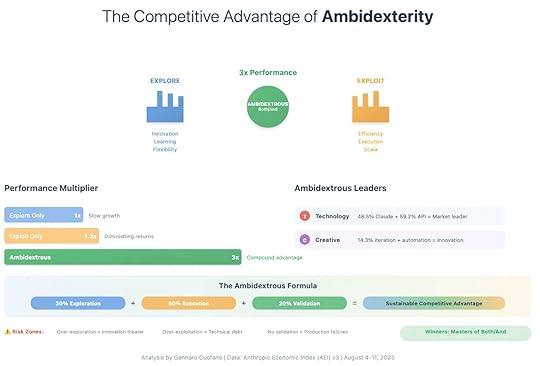The Competitive Advantage of Ambidexterity in AI Adoption

In the race to adopt artificial intelligence, organizations are increasingly forced to make a trade-off: explore new possibilities through augmentation or exploit proven efficiencies through automation. Exploration drives learning, flexibility, and innovation. Exploitation drives execution, scale, and efficiency. Each path has benefits, but each path pursued in isolation has limits. The true competitive advantage comes from mastering both — organizational ambidexterity.
The Limits of Exploration and Exploitation AloneExploration-only organizations suffer from slow growth. They experiment, test, and iterate, but struggle to translate insights into scalable systems. This leads to what is often called “innovation theater”: plenty of pilots, few production wins. Without a path to exploitation, exploration becomes costly and unsustainable.
Exploitation-only organizations scale faster in the short run but quickly hit diminishing returns. Their focus on efficiency makes them brittle. Systems optimized for consistency often lack flexibility. Over-exploitation leads to technical debt, resistance to change, and eventual stagnation. Without exploration, organizations lose their ability to adapt.
The data confirms this. Exploration-only companies track at 1x performance, exploitation-only at 1.2x, while ambidextrous organizations achieve 3x performance. The compounding effect of balancing both paths is not incremental — it is exponential.
The Ambidextrous AdvantageAmbidexterity is not just about balance, but about deliberately combining the strengths of exploration and exploitation while neutralizing their weaknesses. Exploration ensures that organizations continue to learn, test boundaries, and adapt to change. Exploitation ensures that proven approaches are scaled efficiently and consistently.
When combined, exploration fuels innovation pipelines, exploitation turns them into products and systems, and validation ensures outcomes are trusted. The result is a sustainable competitive advantage that competitors locked into one path cannot match.
The Ambidextrous FormulaThe formula for sustainable advantage can be expressed simply:
30% Exploration + 50% Execution + 20% Validation = Competitive Edge
30% Exploration: Enough to keep the organization innovating, experimenting, and learning, without tipping into inefficiency or endless iteration.50% Execution: A majority focus on scaling and delivering results, ensuring proven innovations move into production.20% Validation: A safety layer that ensures trust, reliability, and risk mitigation. Without validation, organizations risk scaling flawed processes and eroding credibility.This formula avoids the three risk zones: over-exploration (innovation theater), over-exploitation (technical debt), and under-validation (production failures).
Ambidextrous Leaders in PracticeTwo industries demonstrate the power of ambidexterity: technology and creative sectors.
Technology combines 48.5% augmentation (Claude) with 59.2% automation (API). This dual mastery has made it the leading sector for AI adoption. Technology firms can experiment broadly and then rapidly industrialize successful approaches. The combination creates both speed and resilience.Creative industries show how ambidexterity fosters innovation. With 14.3% adoption in augmentation and strong automation integration, they translate iteration into scalable creative workflows. Ambidexterity allows them to push boundaries without losing execution discipline.Both sectors prove that ambidexterity is not theoretical. It is a practical competitive advantage already shaping markets.
Performance as a Compound AdvantageThe reason ambidexterity multiplies performance is that the two paths reinforce each other. Exploration generates novel approaches. Exploitation scales them into systems. Validation ensures they are trusted. Each layer compounds the value of the other.
Exploration without exploitation creates ideas with no impact. Exploitation without exploration optimizes for diminishing returns. Validation without both is an empty exercise. Together, they create a flywheel: learn, scale, trust, repeat.
This flywheel is difficult for competitors to copy. Exploration skills, execution infrastructure, and validation systems require different cultures, investments, and leadership models. Building all three in balance is a barrier to entry that produces long-term advantage.
Strategic ImplicationsFor leaders, the ambidexterity challenge is not just operational — it is cultural. Exploration demands curiosity, tolerance for failure, and openness to iteration. Exploitation demands discipline, efficiency, and accountability. Validation demands skepticism, rigor, and independence. Few organizations naturally excel at all three.
This is why ambidextrous leadership is rare. Most executives lean toward one philosophy. Some prioritize innovation, others scale. The leaders who master ambidexterity design organizations where both exploration and exploitation thrive simultaneously. They create dual operating systems: one optimized for experimentation, the other for execution. They enforce validation as the bridge between the two.
Building Ambidextrous OrganizationsThe path to ambidexterity requires intentional design:
Measure adoption behaviors — track how much of organizational activity is exploratory, exploitative, or validation-driven.Set portfolio targets — aim for the 30-50-20 mix, adjusting by industry and context.Invest in dual systems — build infrastructures that support both experimentation and production.Institutionalize validation — treat trust-building as core, not peripheral.Develop ambidextrous leaders — cultivate executives who can switch between innovation and efficiency mindsets.By embedding these principles, organizations move beyond episodic balance toward systemic ambidexterity.
The Winners: Masters of Both/AndThe competitive landscape ahead will not reward those who choose either exploration or exploitation. The winners will be the organizations that master both.
Exploration drives innovation and adaptability. Exploitation drives efficiency and scale. Validation ensures outcomes are reliable. Combined, these create not just performance gains but resilience. In volatile markets, resilience is as valuable as efficiency.
The organizations that achieve ambidexterity will compound advantage. They will grow faster, adapt quicker, and sustain trust longer. Competitors will find it nearly impossible to replicate the cultural and structural duality required.
The formula is clear. 30% exploration, 50% execution, 20% validation. Avoid the risk zones. Balance curiosity with discipline, creativity with consistency, speed with trust. In doing so, organizations do not just survive digital transformation — they shape it.

The post The Competitive Advantage of Ambidexterity in AI Adoption appeared first on FourWeekMBA.



